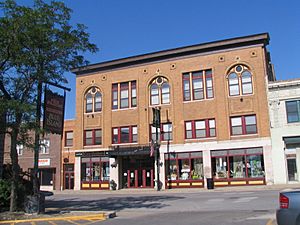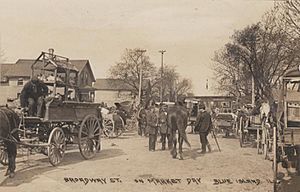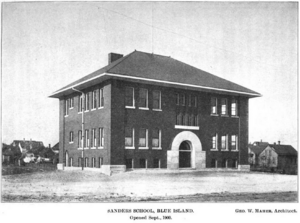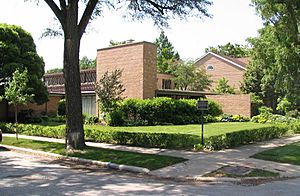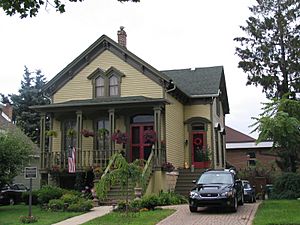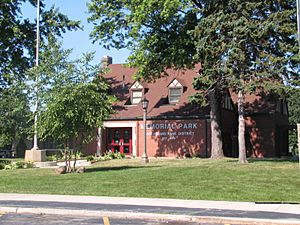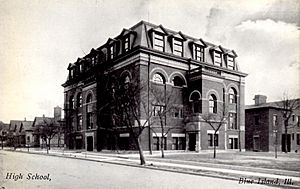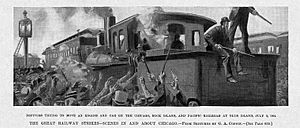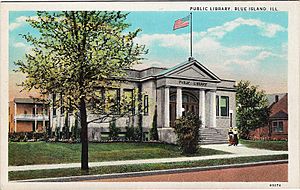Blue Island, Illinois facts for kids
Quick facts for kids
Blue Island, Illinois
|
|||||
|---|---|---|---|---|---|
|
City
|
|||||
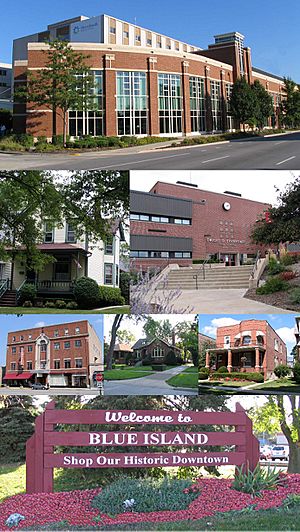 |
|||||
|
|||||
| Nickname(s):
The City on the Hill
|
|||||
| Motto(s):
"Discover Blue Island: The Historic Heart of Chicago Southland"
|
|||||

Location of Blue Island in Cook County, Illinois.
|
|||||
| Country | United States | ||||
| State | Illinois | ||||
| Counties | Cook | ||||
| Townships | Bremen, Worth, Thornton | ||||
| Settled | 1835 | ||||
| Incorporated | October 26, 1872 | ||||
| Government | |||||
| • Type | Mayor-council government | ||||
| Area | |||||
| • Total | 4.16 sq mi (10.77 km2) | ||||
| • Land | 4.07 sq mi (10.54 km2) | ||||
| • Water | 0.09 sq mi (0.22 km2) 2.16% | ||||
| Elevation | 640 ft (195 m) | ||||
| Population
(2020)
|
|||||
| • Total | 22,558 | ||||
| • Density | 5,541.14/sq mi (2,139.34/km2) | ||||
| • Demonym | Blue Islander | ||||
| Time zone | UTC−6 (CST) | ||||
| • Summer (DST) | UTC−5 (CDT) | ||||
| ZIP code |
60406
|
||||
| Area codes | 708/464 | ||||
| FIPS code | 17-06704 | ||||
Blue Island is a city in Cook County, Illinois, United States. It's about 16 miles (26 km) south of downtown Chicago. Blue Island is right next to Chicago, sharing its northern border with the Morgan Park neighborhood. In 2020, about 22,558 people lived there.
The city started in the 1830s as a stopping point for settlers. They traveled on the Vincennes Trace, an old road. Blue Island grew because it was a good distance from Chicago for a day's travel. An early historian, Alfred T. Andreas, called it a "beautiful" and "pleasant" place to live.
For a long time, Blue Island was a key business center in southern Cook County. It had many industries. In the 1840s, it grew during the building of a canal that connected to the Illinois and Michigan Canal. Later, it became famous for making bricks. Blue Island was even called the "brick-making capital of the world." From 1883, the Rock Island Railroad had car repair shops here. The city also had several places that made beer. These stopped operating in 1919 due to a law change. Today, Blue Island has a large hospital and two main clinics.
Many different groups of people have made Blue Island their home. In the 1840s, many Germans arrived. By 1850, about half of the people in Blue Island were either from other countries or their children. Later, people from Italy, Poland, Sweden, and Mexico also came to live here.
The White House has named Blue Island a "Preserve America" community. This means it's recognized for its history and culture.
Contents
- History of Blue Island
- Geography
- Demographics
- Arts and Culture
- Parks and Recreation
- Education
- Infrastructure
- Notable People
- See also
History of Blue Island
How did Blue Island get its start?
Norman Rexford was the first person to settle permanently in Blue Island in 1836. He built the Blue Island House, an inn for travelers. This inn was located on the Wabash Road, which was part of the Vincennes trail. Since it was a day's journey from Chicago, many travelers, soldiers, and cattlemen stopped there. The inn became a central spot for new businesses.
For many years, Blue Island's main shopping area was very important. Locals called it "uptown." It had big stores like Woolworth's and Sears. Today, downtown Blue Island is known for its antique shops, art galleries, and unique food stores. Many "big box" stores have opened outside of town. Still, some local businesses have been around for a very long time. DeMar's Restaurant opened in 1950, Jebens Hardware in 1876, and Krueger Funeral Home in 1858. The city is working on plans to help the historic downtown grow.
The Blue Island Opera House was built after a big fire in 1896. It hosted live shows until 1913, then became a movie theater. Later, it was home to a newspaper and a department store. The building has been beautifully restored on the outside. It is now a local landmark.
What was Market Day?
For many years, Blue Island had a special event called Market Day. It happened on the first Thursday of every month. Farmers from all around came to Western Avenue to sell their goods. They sold produce, farm equipment, and even livestock. Local bands played music for entertainment. Market Day started in the late 1800s. It ended in 1924 because too many sellers offered low-quality items, and farmers stopped coming.
Why was Blue Island known for bricks?
After 1850, people found a lot of clay around Blue Island. This led to a big brick-making industry that lasted over 100 years. At first, bricks were made by hand for local use. But by 1886, companies like Illinois Pressed Brick Company were using machines. They could make 50,000 bricks a day. By 1900, the Clifton Brickyard alone made 150 million bricks a year! Famous architects like Adler and Sullivan even designed buildings for a brickyard here. By the mid-1900s, the brickyards closed. Some became landfills, and one is now a golf course.
Was Blue Island ever called Portland?
Some people think Blue Island was once called Portland. This is not true.
- Norman Rexford named the area "Blue Island" in 1836. He opened the "Blue Island House" inn. The name came from how the distant trees looked like a blue island in the flat prairie.
- In 1839, Peter Barton and others planned a town called "Portland" nearby. They hoped it would be a busy river town. They even changed the local post office name to Portland. But the post office was still in the Blue Island House.
- Portland was never a real town with buildings. Most of it was just a map. People still preferred to live in "Blue Island."
- In 1843, the state of Illinois officially changed the name of "Portland" to "Blue Island." The post office name also changed back.
- In 1850, the post office name changed again to "Worth." This was to match the township name.
- When the Rock Island Railroad started service in 1852, they called their station "Blue Island."
- Finally, in 1860, the post office name went back to "Blue Island" for good.
- On October 26, 1872, Blue Island officially became a village. It used the name "Blue Island," which everyone already knew.
What are some historic buildings in Blue Island?
Blue Island has many old and interesting buildings. The Dr. Aaron Heimbach House (1939) was designed by famous architect Bertrand Goldberg. It's one of only six homes he designed that are still standing. The house is a landmark in Blue Island.
The Bell/Hendriks house was built in 1947 for a special competition. Thousands of people toured this "modified Colonial" home. Its plans were even shown at the Art Institute of Chicago.
The oldest part of Blue Island's city hall was built in 1891. It was designed by Edmund R. Krause, a well-known Chicago architect. The city also has 22 houses that were built from mail-order kits sold by Sears. Blue Island has one building on the National Register of Historic Places. Many other buildings are recognized as local landmarks.
The American House
The American House is one of Blue Island's oldest buildings. It was built in 1839 in Indiana to be a courthouse. But it never served that purpose. In 1844, the building was taken apart and floated on rafts to Blue Island. It was then put back together.
It was a popular place for people from the South to stay in the summer. It also housed workers who built the canal. After the Civil War, it became a home for retired soldiers. Today, it's a private house. You can still see how it was built with large wooden beams.
The Joshua P. Young House
The Joshua P. Young House was built around 1852 by Carlton Wadhams. He was a hotel owner and cattle dealer. Later, he sold the house to Joshua Palmer Young. Young was important in developing many Chicago neighborhoods and nearby towns.
Young also ran the hotel for a while. He was active in local government and helped start a church. He was also involved in creating the Chicago, Blue Island and Indiana Railroad Company. This house is listed on the National Register of Historic Places.
USS Blue Island Victory
On December 28, 1944, a ship named the USS Blue Island Victory was launched. It was a "Victory ship," built during World War II to carry troops and supplies. These ships were called "Ugly Ducklings" by President Franklin D. Roosevelt. About 218 of these ships were named after American cities.
The USS Blue Island Victory was 455 feet (139 m) long and 62 feet (19 m) wide. It had guns to protect itself. The ship carried troops and even cattle. It served in the Korean War and was taken apart in 1972.
Blue Island City Hall
The oldest part of Blue Island's city hall was built in 1891. It was designed by Edmund R. Krause, a famous architect. An addition was built in 1925, designed to look similar to the post office across the street. The Blue Island Post Office was designed by Oscar Wenderoth in 1914.
In the 1870s, Blue Island got its water from three wells. A windmill pumped the water to a big tank on a stone tower behind City Hall. In 1915, the city started getting water from Lake Michigan instead.
Religion in Blue Island
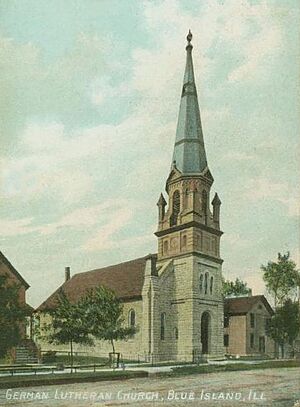
People have gathered for religious services in Blue Island since it was founded in 1836. The first official church services started in 1850. Today, Blue Island still has many of its early churches. It also has new places of worship for its diverse community.
Where did the name "Blue Island" come from?
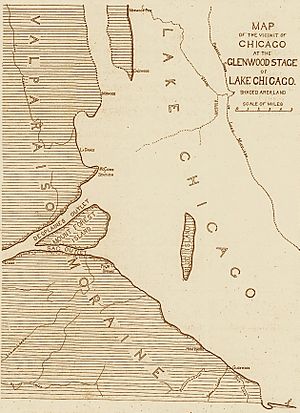
The northern part of Blue Island sits on a ridge of land. Long ago, this ridge was an island when the waters of Lake Chicago covered the area. Early pioneers called it "Blue Island" because from a distance, it looked like an island in a vast grassy plain. The "blue" color might have come from how the air made distant objects look blue, or from blue flowers growing on the ridge.
In 1834, the Chicago Democrat newspaper described it: "Nearly south of this town and twelve miles [19 km] distant is Blue Island. This name is particularly appropriate. It is a table of land about six miles [10 km] long... rising some forty feet [12 m] out of an immense plain... The ridge, when viewed from a distance, appears standing in an azure mist of vapor, hence the appellation 'Blue Island'."
Geography
Blue Island covers about 4.16 square miles (10.77 km2). Most of this area is land, with a small part being water.
Surrounding areas
Demographics
| Historical population | |||
|---|---|---|---|
| Census | Pop. | %± | |
| 1880 | 1,542 | — | |
| 1890 | 3,329 | 115.9% | |
| 1900 | 6,114 | 83.7% | |
| 1910 | 8,043 | 31.6% | |
| 1920 | 11,424 | 42.0% | |
| 1930 | 16,534 | 44.7% | |
| 1940 | 16,638 | 0.6% | |
| 1950 | 17,622 | 5.9% | |
| 1960 | 19,618 | 11.3% | |
| 1970 | 22,629 | 15.3% | |
| 1980 | 21,855 | −3.4% | |
| 1990 | 21,203 | −3.0% | |
| 2000 | 23,463 | 10.7% | |
| 2010 | 23,706 | 1.0% | |
| 2020 | 22,558 | −4.8% | |
| U.S. Decennial Census 2010 2020 |
|||
| Race / Ethnicity (NH = Non-Hispanic) | Pop 2000 | Pop 2010 | Pop 2020 | % 2000 | % 2010 | % 2020 |
|---|---|---|---|---|---|---|
| White alone (NH) | 8,498 | 4,990 | 3,442 | 36.22% | 21.05% | 15.26% |
| Black or African American alone (NH) | 5,599 | 7,173 | 6,817 | 23.86% | 30.26% | 30.22% |
| Native American or Alaska Native alone (NH) | 40 | 42 | 38 | 0.17% | 0.18% | 0.17% |
| Asian alone (NH) | 78 | 79 | 86 | 0.33% | 0.33% | 0.38% |
| Pacific Islander alone (NH) | 6 | 6 | 6 | 0.03% | 0.03% | 0.03% |
| Other race alone (NH) | 25 | 43 | 64 | 0.11% | 0.18% | 0.28% |
| Mixed race or Multiracial (NH) | 318 | 240 | 385 | 1.36% | 1.01% | 1.71% |
| Hispanic or Latino (any race) | 8,899 | 11,133 | 11,720 | 37.93% | 46.96% | 51.95% |
| Total | 23,463 | 23,706 | 22,558 | 100.00% | 100.00% | 100.00% |
In 2020, Blue Island had 22,558 people living in 7,926 households. About 34.9% of households had children under 18. The city's population was 51.95% Hispanic or Latino. The median age was 35.9 years. The average household size was 3.56 people. The median income for a household was $51,859.
Arts and Culture
Tourism
Blue Island Area Sports Hall of Fame
The Blue Island park district helps the community by offering sports like Little League Baseball and football. It also hosts the Blue Island Area Sports Hall of Fame. This Hall of Fame has photos and stories of many people who have done great things in sports, both locally and internationally.
Parks and Recreation
The park district started in 1909. In 1912, it bought land from Benjamin Sanders, Blue Island's first village president. This land became Central Park. It had tennis courts, playgrounds, and the first swimming pool. In 1965, the park was sold to a hospital.
Memorial Park was opened in 1922. Part of this park used to be a cemetery in the 1850s. The cemetery was closed in 1898, and most of the people buried there were moved. By 1935, Memorial Park grew to 10 acres (4.0 ha). It got landscaping, an outdoor swimming pool, and a stadium. Today, Memorial Park is the main park in Blue Island.
Centennial Park, on the east side of Blue Island, was bought in 1935. This 8.5-acre (3.4 ha) park has a field house, sports fields, and playground equipment.
The city also runs the Meadows Golf Club. It's an 18-hole golf course that opened in 1994.
Education
Blue Island was an important center for learning in the mid-1800s. A private school for girls opened in 1845. Public education started in 1846 with a one-room schoolhouse. This old schoolhouse still stands today as a remodeled home.
Chicago State University was founded in Blue Island in 1867. It started as a teacher's school in the old Whittier School building. This lasted until 1870, when the college moved to a new campus in Chicago.
The public school district (Cook County School District 130) was created in 1887. The current high school district (Community High School District 218) started in 1927. Blue Island Community High School (now Dwight D. Eisenhower High School) was recognized as a good school in 1899. In 1951, Dwight D. Eisenhower spoke at the dedication of the new high school building. The school was renamed in his honor in 1962.
Some parts of Blue Island are also served by the Posen-Robbins School District 143½.
Elementary and Middle Schools
Most kids in Blue Island go to schools in Cook County School District 130. This district serves Blue Island and parts of other towns. A small part of Blue Island is in Calumet Public School District 132.
Here are some public schools in District 130:
- Everett F. Kerr Middle School – for grades 6–8
- Greenbriar School – for students needing special placement, grades 1–8
- Greenwood School – used for parent education
- Horace Mann – for pre-kindergarten students
- Lincoln Elementary School – for grades K–3
- Paul Revere Intermediate School – for grades 4–6
- Paul Revere Primary School – for grades K–3
- Veteran's Memorial Middle School – for grades 6–8
- Whittier Elementary School – for grades 4–6
Private elementary and middle schools include:
- St. Benedict School
High Schools
The public high school is:
- Dwight D. Eisenhower High School
In 1903, a separate high school district was created. Blue Island Community High School District 218 was established in 1927.
There are no active private high schools in Blue Island now. Mother of Sorrows High School for Girls operated from 1954 to 1983.
Higher Education
- Moraine Valley Community College has a campus in Blue Island.
Special Education
Public schools for special education include:
- Able Program, Garfield School
- Academy for Learning
A private school for special education is:
- Blue Cap School
Infrastructure
Transportation
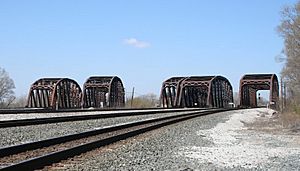
Public Transportation
Blue Island is a hub for Metra trains. It has six train stations. Four of them are on the Rock Island District line: 119th Street, 123rd Street, Prairie Street, and Vermont Street.
The Rock Island District line splits off to serve Chicago neighborhoods like Beverly Hills. The Vermont Street station is one of the oldest Metra stations, built in 1868. This station was part of a big historical event on June 29, 1894. There were riots in the Blue Island train yards. This happened after a speech by Eugene Debs, who supported striking workers. Buildings were set on fire, and a train was pushed off its tracks. President Grover Cleveland sent federal troops to keep the peace.
The fifth station is across from Vermont Street. It's the end of a Metra Electric train line. The sixth station on this line is a half mile north on Burr Oak Avenue.
Blue Island also has bus service provided by Pace Suburban Bus.
Other Transportation
Blue Island is about 34 miles (55 km) from O'Hare International Airport and 12.5 miles (20.1 km) from Midway International Airport. It's close to major highways like Interstate 57 and the Tri-State Tollway. Western Avenue, a main road in Blue Island, is part of the historic Dixie Highway. This highway once connected Chicago all the way to Miami, Florida.
Public Library
Blue Island has had a library since about 1845. Thomas McClintock let people borrow books from his private collection. In 1854, the library moved into the new Whittier School building. In 1890, a women's club opened a small reading room with about 1,500 books. This collection was destroyed in the Great Blue Island Fire of 1896.
The public library, supported by taxpayers, was founded in 1897. In 1903, Andrew Carnegie gave money to build a new library building. This building was torn down in 1969 to make way for the current library. Today, the Blue Island Public Library offers many services. These include books in different languages, computers with internet, and educational programs. It also hosts the Blue Island Historical Society's Museum Room.
Notable People
- Marcheline Bertrand, actress and mother of Angelina Jolie, was born here.
- Gary Bettenhausen, a champion race car driver.
- Peter Brown, singer-songwriter who co-wrote Madonna's "Material Girl."
- Danny Clark, NFL linebacker.
- Curtis Granderson, a three-time All-Star baseball outfielder.
- Helen L. Koch, a psychologist who studied twins.
- Don Kolloway, Major League Baseball infielder.
- Tony Lovato, musician in the band Mest.
- Douglas A. Melton, a Harvard professor and stem cell scientist.
- Joe Moeller, Major League Baseball pitcher.
- Rob Ninkovich, two-time Super Bowl champion for the New England Patriots.
- Christian Picciolini, author and social justice activist.
- La Julia Rhea, the first black performer to star in a major opera.
- Rick Rizzs, Major League Baseball commentator.
- Ronald Rotunda, a noted legal scholar.
- Eugene Rousseau, a famous saxophonist.
- Robert A. Schuller, televangelist.
- Gary Sinise, actor, director, and musician.
- Anthony E. Zuiker, creator of the TV series CSI.
- Chip Z'nuff, bassist and frontman of the rock band Enuff Z'nuff.
|
See also
 In Spanish: Blue Island para niños
In Spanish: Blue Island para niños








